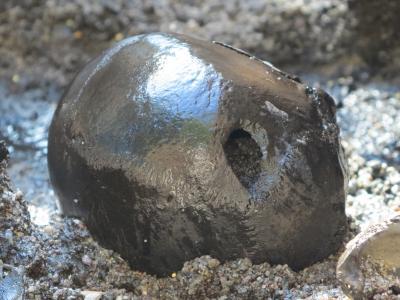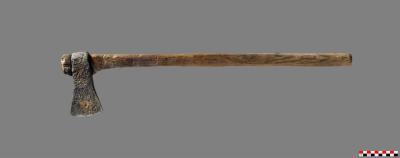A fractured skull and a thigh bone hacked in half and numerous other finds of damaged human bones along with axes, spears, clubs and shields confirm that the bog at Alken Enge was the site of violent conflict. For almost two months, Project Manager Mads Kähler Holst, professor of archeology at Aarhus University, and a team of fifteen archaeologists and geologists have been working to excavate the remains of a large army that was sacrificed at the site around the time of the birth of Christ. The remains will be exhumed from the excavation site over the coming days. Then an international team of researchers will attempt to discover who these warriors were and where they came from by performing detailed analyses of the remains.
"The dig has produced a large quantity of skeletal remains, and we believe that they will give us the answers to some of our questions about what kind of events led up to the army ending up here," explains Holst.

The first skull from the 2012 dig with a mortal wound caused by a spear or an arrow. Credit: Curator Ejvind Hertz, Skanderborg Museum
The find is so massive that researchers aren't counting on being able to excavate all of it. Instead, they will focus on recreating the general outlines of the events that took place at the site by performing smaller digs at different spots across the bog and reconstructing what the landscape might have looked like 2,000 years ago. The archaeological investigation of the site is nearing its conclusion for this year but there are many indications that the find is much larger than the area archaeologists have excavated thus far.
"We've done small test digs at different places in the 40 hectare Alken Enge wetlands area, and new finds keep emerging," says Field Director Ejvind Hertz of Scanderborg Museum, who is directing the dig.

Iron axe with shaft, approximately 75 cm in length. Credit: Fotograf Rikke Grøn Larsson. Foto/Media department Moesgaard
"The geological survey indicates that the archaeological finds were deposited in a lake at a point in time when there was a a smaller basin at the east end of Lake Mossø created by a tongue of land jutting into the lake," explains Professor Bent Vad Odgaard from Aarhus University.
This smaller basin became the Alken Enge bog of today. The geologists' analyses also indicate that the water level in the area has changed several times. Mapping these periods of high and low water levels chronologically using geological techniques will tell researchers what the precise conditions were on the site at the time of the mass sacrifice.






Comments